Cruising in the “tropics” – ehhhh
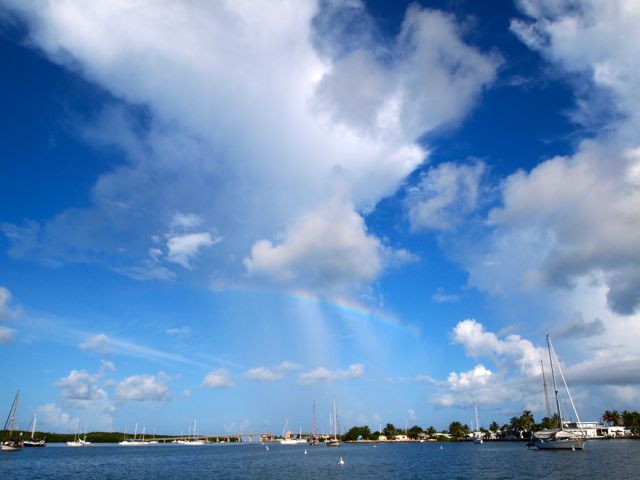
After Shearwater arrived in Florida in early June, we began to finalize our plans to retrieve her and bring her to Texas. Since we would need to take the boat around the south coast of Florida anyway, it seemed like a no-brainer to make a short vacation out of the trip and see more of the Florida Keys at the initial part of our 1,000-mile delivery to Texas. We even encouraged some good friends to come along for the ‘fun’…
Our main issue was the heat – we apparently don’t thrive in it (remember our previous plan was to take the boat to Sweden!) And, as it turns out, south Florida in June is rather hot and unbearable at times on a small boat without air-conditioning or many opening ports (great for Sweden). We have small Hella fans in the v-berth, as well as a 12-volt portable turbo fan that can spin up to a million rpm’s (and you know it because it sounds like an airplane turbine at top speed) for the aft berth – all of the fans helped. We also had picked up a Wind Scoop at a used boat parts store in Annapolis before leaving for Europe last summer that turned out to be a smart impulse buy. Our refrigerator on the boat managed to continue operating, but not nearly as well as we hoped. It managed to take the tepidness out of the water temperature, but hardly what you would hope for when you are really hot, rather tired and ready for a break. The rate of food spoilage increased by probably 50% because we couldn’t keep things as chilled as they normally would have been.
Our trip was also tinged with an initial frenzy of needing to get a number of things done before heading out on the trip – another trip up the mast to replace the anemometer that broke off the coast of Portugal, provisioning, as well as general clean-up and laundry tasks from our Portugal-to-Gibraltar trip (we had only 3 hours after arrival in Gibraltar to take care of the boat before having to return to Spain). By the time our friend arrived, we were slightly dazed from the heat and effort to take care of the list of to-do items…but we managed to complete the critical items.
Our first day was a long trip of 75nm, hampered further by adverse current. We left North Palm Beach early, made excellent time through water, often sailing at over 8 knots, but with the current we didn’t arrive to the anchorage at No Name Harbor on Key Biscayne until 8:30pm…after anchoring, we excitedly rowed ashore where a restaurant that had been booming music minutes before suddenly went silent and locked its doors 5 minutes before 9pm when they were due to close. We rowed back to the boat and had a basic meal on the boat, a bit disheartened since we were all thinking about how good a really cold drink would have been. The next morning, we explored the area more – the little hurricane-hole bay was nearly 100% protected and surrounded by a state park. It would have been a great place to enjoy longer, but we headed out to stay on schedule.
Our next planned stop was a place called Cesar Creek – someone from one of the sailing boards online had suggested the area as a place we might anchor. One of the challenges for us in Florida (or anywhere shallow, for that matter) is our 7-foot draft, and Justin had solicited ideas on some of the boards he follows to help us figure out destinations. We were pretty excited about the prospect of a short 21nm passage that would afford the opportunity to explore off the boat. We arrived to the access channel from Hawk Channel in the early afternoon, and we began to make our way into the access channel. Within 5 minutes, we were aground – parked squarely in the middle of the marked channel.
We tried healing the boat with the sails, motoring in different directions…and then made the dreaded call to the Sea-Tow folks because we were growing increasingly concerned that we might not be able to fix our situation ourselves. A boat arrived within an hour and very clearly requested our acceptance of the price for his “timely arrival and stupidity-fix” services of $900. We agreed, and took his line to the bow where within minutes, one of our bow chocks had exploded. After aborting that approach, Mr. Sea-Tow had us attach his line to a halyard, and we then crossed our fingers as he heeled us 45 degrees and told us to gun the engine. Nada. We weren’t going anywhere any time soon. He told us he would send someone else out at 11:30pm that evening (we ran aground at 1:30pm), when the tide would be higher. So we waited – watching the depth sounder and water creeping up on the channel markers. At approximately 7pm, we noticed the boat moving a little more with the rising water. We decided it would be good to put out the anchor as a kedge using the dinghy, and we slowly began pulling the boat against the anchor. The good news was the tow boat had rotated us so that least we were pointed directly towards deeper water. By 9pm, we were free and clear. By 9:01pm, the call was made to Mr. Sea-Tow that his kind services were no longer needed – we “saved” ourselves the $900, but decided to get the towing insurance for $150 for the remainder of the trip, just in case. For the remainder of the night we had a really pleasant sail in flat water and a bright moon without the heat making great progress towards Marathon. We weren’t up for risking another attempt at a dodgy anchorage along the way.
The following several days were spent in Marathon, exploring places like the Dolphin Research Center, the Turtle Hospital and Crane Point Museum and Nature Center.
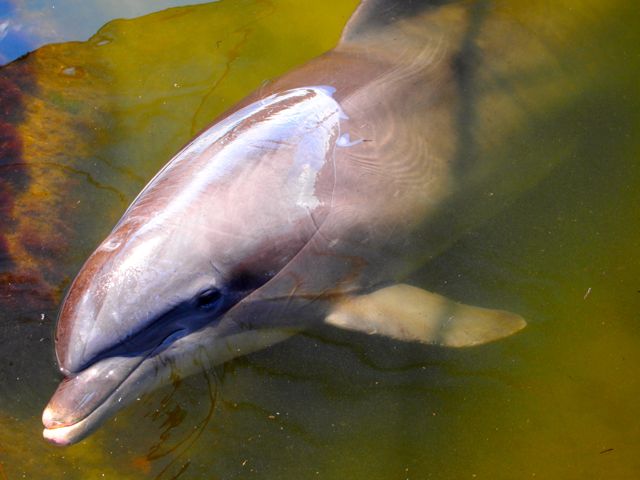
A bottlenose dolphin at the Dolphin Research Center – the nonprofit facility educates, rehabilitates and actively participates in cetacean research.
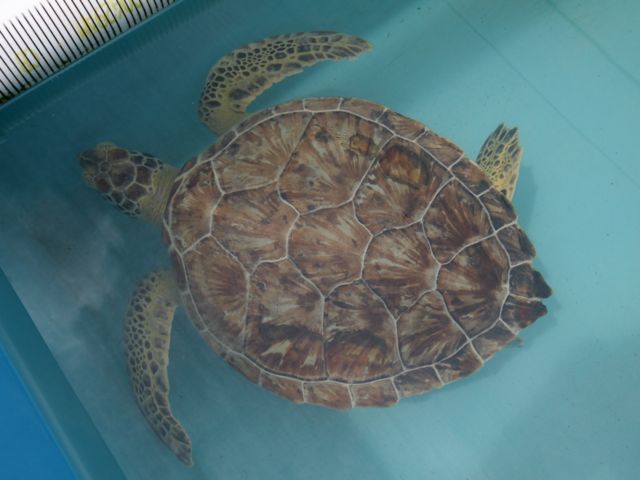
A green sea turtle at the Turtle Hospital in Marathon. The center assists turtles that have been injured or that are suffering from fibropapilloma, releasing 60-70 turtles back into the wild each year.
We had picked up a mooring in the middle of the harbor to accommodate our 7′ draft. That required a LONG row the first day without an outboard. A quick trip to a local shop fixed that problem, and life was better not having to row the mile to shore. The city marina had nice facilities and a large common area that, although not air-conditioned, had lots of shady breeze blowing through the building where movie theater seats and TVs mounted to the wall allowed you to remember what life was like outside of a boat exposed to the incessant mid-day sun and not enough breeze. We had our share of good seafood and drinks ashore, too.
The highlight of the time in Marathon was spending a few hours snorkeling at Sombrero Reef, approximately 3 miles offshore. We planned our day-trip thinking that everyone and their brother also had the same trip in mind, so we left at 4:30am. That, and we needed to get out of Boot Key Harbor before low tide. We arrived – the first boat to the reef, where we picked up one of the available moorings that had been placed to encourage boaters to not anchor on the sensitive reef. One other boat also arrived early – their goal was to poach the waters (fishing is not allowed in National Marine Sanctuaries). We called to them to “suggest” that there should not be any fishing, but they ignored us…and in our snorkel gear, we were not able to take down their boat registration numbers. Irritation aside, we started snorkeling and were amazed by the diversity and number of fish. For Justin and I, it was one of the best snorkeling experiences we have had, up there with swimming in the Channel Islands in California. We took some video while snorkeling, including Justin chasing after a five-foot barracuda. By the time we dropped the mooring and headed back to Boot Key Harbor there were 15 or so boats, including two “cattlemarans” of tourists. We were glad we headed out early.
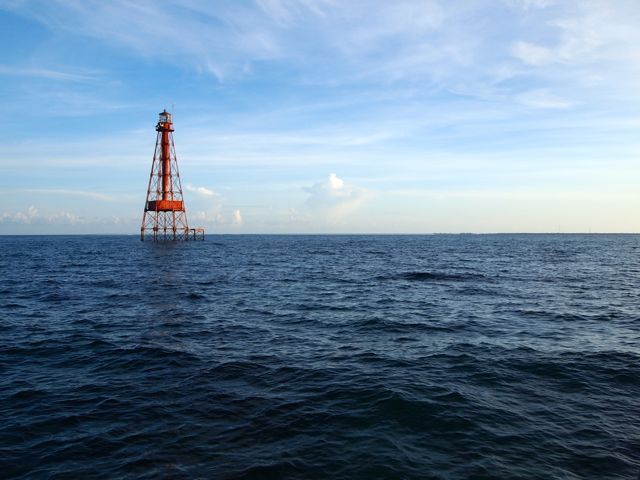
Sombrero Reef – the light tower marks the reef area. Mooring balls have been placed to allow snorkelers to enjoy the reef while protecting the reef from boat anchors.
All in all, we probably won’t make an effort to pass through Florida again – deeper water and cooler temperatures make life much more enjoyable for us. Our poor friends did not get the best snapshot of what cruising can be, but we’ll try to make it up another time.
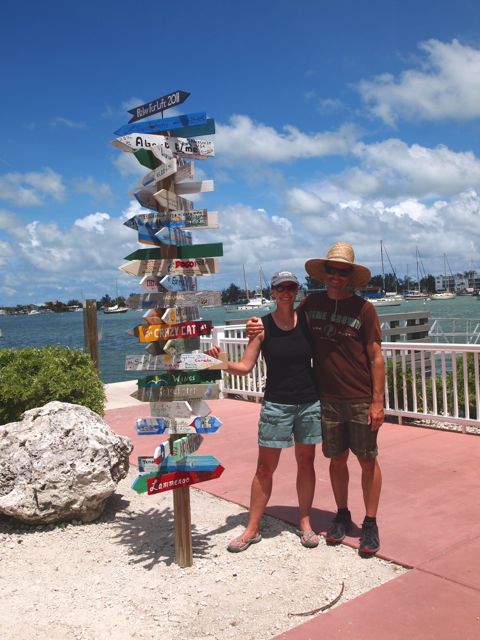
At Marathon City Marina – funny enough, the signs above included a boat named “Earendil” that was NOT our old Valiant 32 (we were not as original as we thought!).
1 comment
Leave a ReplyCancel reply
Sign up to receive blog updates
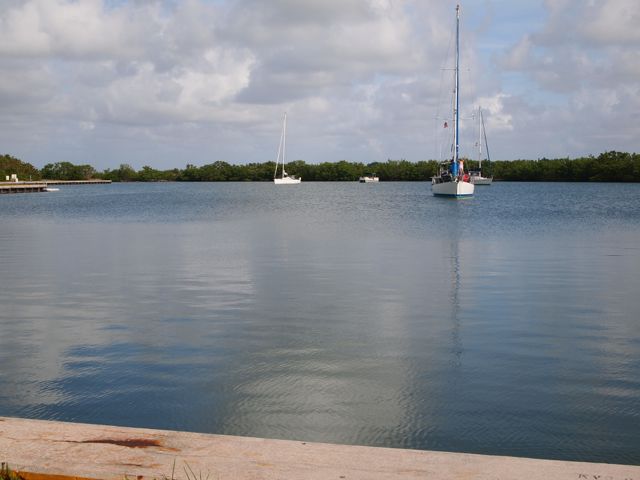

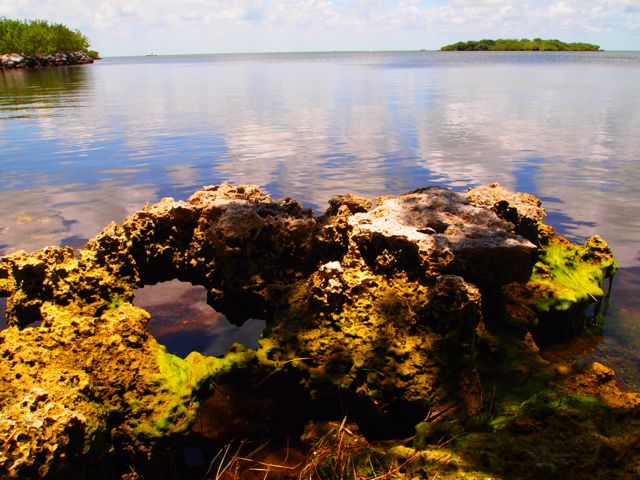

sounds like you had a great time, speak soon, good luck with the rest of the trip
all our love Boba nd Cheri